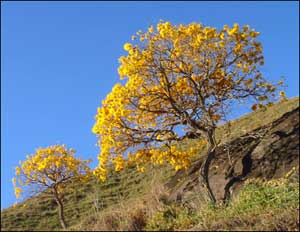Golden Trumpet Tree

Golden trumpet tree is a wintertime showstopper, erupting with an amazing display of yellow trumpet-shaped blooms before the tree’s leaves appear in the spring. It is a beautiful, medium-sized tree that works well in Central and South Florida landscapes.
Characteristics
Previously known by the scientific name Tabebuia chrysotricha, golden trumpet tree is native to Central American and northern South America. It grows best in USDA hardiness zones 9b-11, though specimens have been spotted as far north as Gainesville.
In addition to the golden trumpet, there are several other trumpet trees with various flower colors, including pink and purple, that share most of its desirable traits and should also be considered for wider use.
The tree can be up to 80 feet tall in its native habitat, but usually reaches 30–40 feet in cultivation, making it a good size for most home landscapes. The open, spreading canopy makes it an attractive shade tree for Florida’s hot summers.
Planting and Care
Golden trumpet tree grows well in Florida’s sandy soils and is drought tolerant, though it needs regular water for the first several weeks after planting. It will perform best in sunny locations.
Trees can be started from seed—just wait for the seed pods to crack open and then plant them in a light, moist potting medium—and then transplanted into the landscape once they are large enough.
For more information on golden trumpet tree, contact your county Extension office.
New Name
In 2007, studies on Tabebuia had the effect of splitting some members of the genus, including the golden trumpet tree, into the new genus Handroanthus. Because of this, Tabebuia chrysotricha becomes Handroanthus chrysotrichus. (Susan O. Grose and Richard G. Olmstead. 2007. “Taxonomic Revisions in the Polyphyletic Genus Tabebuia s.l. (Bignoniaceae)”. Systematic Botany 32(3):660-670.)
